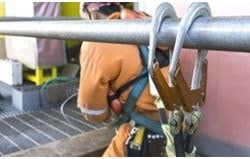Reference: Safeopedia
Takeaway: Choosing the right lanyard is as important as choosing the right harness. Find out what you should consider when equipping your fall protection or fall arrest system.
I was working from a scissor lift one day with my partner, and we couldn’t quite get close enough to the spot we needed to reach. My partner stepped up on the lower guardrail to get the extra height he needed. He’s a big guy, and very strong. When he finished sticking the material where it needed to be, he pushed off the overhead beam and jumped back onto the floor surface of the lift. This made the lift sway, and I thought for a minute that we might tip.
When we got back to the ground, one of the electricians who had been working nearby mentioned that all it takes to tip a scissor lift is 200lbs of force and that if my partner would have pushed off just a bit harder we might have gone over. He also told us that we shouldn’t be wearing shock-absorbing lanyards because if we did tip, they wouldn’t help us at all. I was amazed that my employer had not mentioned the fact that we need different lanyards for different lifts. It’s a good thing that electrician shared this information with us before someone fell while wearing the wrong gear.

Fall Protection Lanyards
Lanyards are a part of both fall protection plans and fall arrest systems and they’re just as important as the harnesses worn by workers at height. Fall protection PPE can save your life—but only if you’ve got the right kind of equipment.
Anyone working at heights should wear a fall protection gear if there’s any chance they might fall out of a lift, lose their balance near a ledge, or get bumped into while working on a scaffold. Seems simple enough, right? And yet, day after day, workers climb up to do a job while using the wrong type of lanyard.
It seems like a simple enough concept: if you’re working at height, you need gear that will catch you if you fall, preferably before you hit the ground. But day after day, workers use the wrong type of lanyards.
Follow these tips to make sure you’re choosing the right equipment.
Quick Tips
Types of Lanyards
Start by knowing the two basic types of lanyard.
Unless you’re using travel limiting devices or retractable lanyards, fall arrest system lanyards need to be equipped with shock absorbers that limit fall force to less than 1,800lbs (8kN). Make sure to note the lanyard’s length when it is fully deployed and make sure that the total fall distance is calculated correctly.
A self-retracting lanyard (SRL), on the other hand, acts as a fall limiter, not a form of fall arrest. The idea behind SRLs is to prevent the fall from happening in the first place by limiting the wearer’s travel distance and locking when excessive force is applied to the line. Because they are designed for this purpose, SRLs are typically non-shock-absorbing.
Connectors / Hooks
There are two main types of connectors available. The first is a classic snap hook, and the second is a rebar hook. The demands of the job and the anchorage used will dictate the most appropriate connection type.
Double Legged vs. Single Legged Lanyards
Lanyards come in single legged and double legged form. Which of the two you will need depends on the kind of work being done. If workers have to move around a lot during their work, opt for a double legged lanyard. That way, workers can move to a different anchor point while still being connected.
Lanyard Material
You may need to select lanyard material that has special properties. The last thing you want is for a welder’s safety to be compromised because their lanyard was damaged by sparks or flame, so if there is any welding going on make sure you equip workers with char-resistant lanyards.
Lanyards are usually available in chain or webbing form, and the webbing can be made of different materials, depending on your needs.
The Right Lanyard for the Job
If there is one message here, it’s that just as different jobs require different types of harness, so they might require different lanyards. Workers need to be equipped with a lanyard that will protect them given their actual work environment and the nature of the work they’re doing.
I’ll leave you with a few examples:
- Anyone working from a boom lift or man lift will need to use an adjustable lanyard so they can set the length for the height they’re working at. Remember, a lanyard that takes eight feet to stop a fall is useless for someone working at six feet
- Working from a leading-edge without a guardrail system in place requires a retractable lanyard.
- Only retractable lanyards should be used when working from a scissor lift. Adjustable or shock-absorbing lanyards should never be used in these cases because the force generated from a fall outside the lift will tip the lift before the lanyard has a chance to save the wearer.
